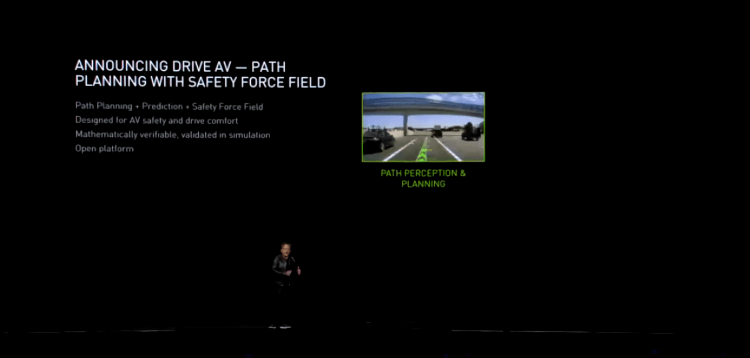Watch all the Transform 2020 sessions on-demand here.
Today at Nvidia’s GPU Technology Conference in San Jose, CEO Jensen Huang detailed the latest developments regarding the chipmaker’s autonomous driving efforts. He revealed that Nvidia Constellation, its cloud-based autonomous vehicle simulation platform, is now generally available, and announced Safety Force Field, a new component of the company’s Drive AV platform designed to protect driverless cars, their occupants, and the cars and passengers with which they’re sharing the road.
Nvidia’s Safety Force — which is built into Nvidia’s Drive autonomous vehicle software suite — seems squarely aimed the roughly three-quarters of consumers who told the American Automobile Association (AAA) in a recent study that they were wary of riding in self-driving cars. Boiled down to basics, it’s a decision-making policy in a motion-planning stack that monitors unsafe actions by analyzing real-time sensor data. It makes predictions with the goal of minimize harm and “potential danger,” and according to David Nister, vice president of autonomous driving software at Nvidia, its framework ensures that the actions it recommends never create, escalate, or contribute to unsafe situations.
“By removing human error from the driving equation, we can prevent the vast majority of collisions and minimize the impact of those that do occur,” Nister said.
So how does it accomplish that? With “robust” mathematical calculations backed by physics-based “zero-collisions” verifications rather than real-time models that draw on limited statistics. As Nister explained it, it follows a single core principle — collision avoidance — as opposed to a range of rules and expectations. Said calculations are performed on-vehicle and frame-by-frame, Nvidia says, and have been validated using both real-world and “bit-accurate” synthetic data entailing high-risk highway and urban driving scenarios.
June 5th: The AI Audit in NYC
Join us next week in NYC to engage with top executive leaders, delving into strategies for auditing AI models to ensure fairness, optimal performance, and ethical compliance across diverse organizations. Secure your attendance for this exclusive invite-only event.
Somewhat uniquely, Safety Force Field can take into account both braking and steering constraints, enabling it to identify and eliminate “anomalies” arising from both. “SFF is mathematically designed such that autonomous vehicles equipped with SFF will, like magnets that repel each other, keep themselves out of harm’s way and not contribute to unsafe situations,” Nister added.
It’s not a new idea, per se. Intel’s Mobileye self-driving car division took the wraps off of its own mathematical collision avoidance model — Responsibility-Sensitive Safety (RSS) — in October 2017 at the World Knowledge Forum in Seoul, South Korea, which it describes as a “deterministic … formula” with “logically provable” rules of the road. Less abstractly, it’s a “common sense” approach to on-the-road decision-making that codifies good habits, like maintaining a safe following distance and giving other cars the right of way.
More recently, Mobileye CEO Amnon Shashua posited an augmented form of automatic emergency braking — automatic preventative braking (APB) — that uses formulas to determine when cars are entering a dangerous situation. The idea is to prevent collisions by bringing vehicles a slow, gradual stop when a potential hazard comes into view. According to Shashua, if APB were installed with a single forward-facing camera in every car, it would eliminate a “substantial” portion of front-to-rear crashes resulting from careless driving.
It remains to be seen if Safety Force Field and its brethren are enough to convince a skeptical public. To be fair, the industry hasn’t instilled much confidence.
In March 2018, Uber suspended testing of its autonomous Volvo XC90 fleet after one of its cars struck and killed a pedestrian in Tempe, Arizona. Separately, Tesla’s Autopilot driver-assistance system has been blamed for a number of fender benders, including one in which a Tesla Model S collided with a parked Culver City fire truck. (Tesla stopped offering “full self-driving capability” on select new models in early October 2018.)
Assuming they work as promised, tech like Safety Force Field, RSS, and APB could go a long way to restoring faith in driverless cars — and might be a godsend for the millions of people who risk their lives every time they step into a car. About 94 percent of car crashes are caused by human error, and in 2016, the top three causes of traffic fatalities were distracted driving, drunk driving, and speeding.
“[Safety Force Field] is technology that we’ve been researching and developing for years to increase the safety of autonomous vehicles,” Danny Shapiro, Nvidia’s senior director of automotive, told reporters during a briefing ahead of this afternoon’s keynote. “It’s something that will be available for the industry to utilize and something that we’re building into our drive software stack.”
Safety Force Field dovetailed with the debut of Nvidia’s Drive AP2X, a full stack “autopilot” autonomous system Nvidia says can guide a car “on-ramp to off-ramp,” with features like surround perception for auto lane-change, localization to “all major HD maps,” real-time mapping with camera and radar, integrated AR and VR visualizations, and integrated voice commands.


